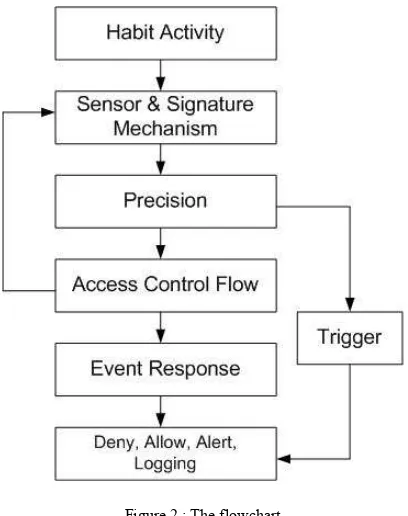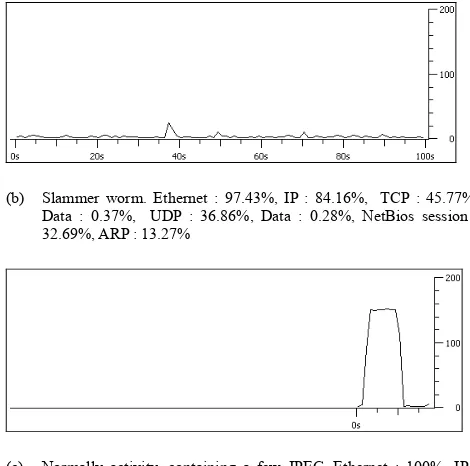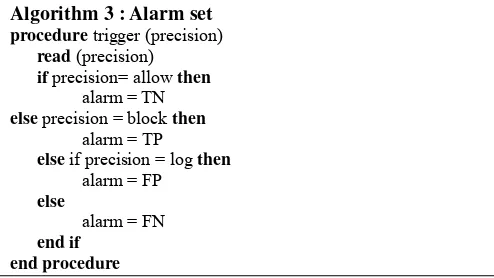The Prevention Threat of Behavior-based Signature using
Pitcher Flow Architecture
Deris Stiawan1&2, Abdul Hanan Abdullah2, Mohd. Yazid Idris2 deris.stiawan@gmail.com, {hanan, yazid}@utm.my
1)
Computer Engineering Department, Faculty of Computer Science, Sriwijaya University, Indonesia 2)
Facultyof Computer Science & Information System, Univesiti Teknologi Malaysia
Summary
In recent years, Intrusion Prevention System (IPS) has been widely implemented to prevent suspicious threats. Unlike the traditional Intrusion Detection System, IPS has additional features to secure the computer network system. IPS is an access control device with a prevention function, which enforces a network security policy, is a helpful device that allows for more granular blocking action.
In this paper, we propose a new prediction and prevention method with behavior-based detection, this method is called pitcher flow. We describes the habitual activity of the performance an overall network with a new algorithm for identifying and recognizing the normal behavior of user activities in the internal network. First, we define behavior activity by duration of activity conducted and active connection. Second, we categorize packets into class/type, identifying parameters by classifying the packets. Finally, we use the pitcher flow mechanism to identify and recognize suspicious threats. This paper also describes an algorithm for the complexity of the suspicious response.
Key-words:
Behavior-based detection, Hybrid intrusion prevention, Identify habitual activity.
1. Introduction
In the last few years, the Internet has experienced explosive growth. Along with the widespread evolution of newly emerging services, the quantity and impact of attacks have been continuously increasing as well. Intrusion Prevention System (IPS) has become an essential component of computer security to predict and prevent attacks. They monitor, identify and recognize all real-time packets inbound and outbound. IPS, which proactively combines the firewall technique with that of the Intrusion Detection System, prevents attacks from entering the network by examining various data records and the detection demeanor of the pattern recognition sensor, when an attack is identified, intrusion prevention blocks and logs the offending data.
According to CSI/FBI survey [9], the company business has dollar amount of loss by type of attack.
Meanwhile, to secure the systems, the enterprise uses several technology security systems, and almost 69% of which use intrusion prevention to defend from threat and attack.
The signature is the primary means to identify activity in network traffic, and the host performs the detection of inbound and outbound packets and to block that activity before damage and network resources are accessed. However, IPS can effectively detect suspicious threats that are already known from a list of signatures. Common Vulnerability Exposure (cve.mitre.org) is a list of intruding products, and there are several IPS devices with proprietary standards. For this reason, many IPS vendors dedicate a large number of engineers to continuous observation of suspicious threats and update their product database with new signatures as threats arise.
From our observation, many devices are defined through the process of identifying suspicious threats and rogue activity from inbound network traffic. Unfortunately, computer misuse or malicious activity from inside the network not the main issue in past research, and it is important to understand how to identify a compromised system by inspecting outbound traffic. It is a broader term that encompasses indentifying a variety of suspicious, rogue and malicious threats in outbound user activity. They are, (i) spam e-mail, (ii) theft of intellectual property, (iii) computer zombie from inside network to trigger attack, and (iv) internal system that launches scanning and exploits until it launches a DoS attack against the host on the Internet. Therefore, this action triggers revenge action from outside.
The rest of this article is organized as follow. Section 2, we review related work. Section 3, describes Pitcher Flow architecture and its algorithms. Section 4 includes concluding remarks.
2. Related Work
For detecting an intrusion based on the behavior of a user's activities, previous works have concentrated on [1], identifying application’s types solely by transport layer communication patterns, excluding payload data patterns. [2] asynchronous event sequences and data pattern comparison between correlation among random order communication (e.q. bot command and windows executable file). The signature is the primary factor in intrusion prevention, because it triggers an alert. There are three trigger mechanisms : (i) pattern-based prevention, (ii) anomaly-based prevention, and (iii) behavior-based prevention [2],[3],[4].
Previous work on a method based behavior model [3] has proposed an idea for the behavior rule that uses correlations between packet/payload data patterns and communication patterns. The scenario-based intrusion detection method has similar features based on state transition machine, however, scenarios of compromise consist of not only sequential events but also random order events and certain scenarios that have to be described involved complicated correlations between communications.
Proposal [4], describes a method for anomaly intrusion detection on linear prediction and Markov chain model, they combine with signature verification to detect attacks more efficiently. They introduced a method for detecting intrusion based on the temporal behavior of applications, using dataset from University of New Mexico (cs.unm.edu/~immsec/data-sets.htm), and then they [5] proposed anomaly intrusion using temporal information of the privilege program with a method based on linear prediction and Markov chain.
The objective of this survey [6] is to study perceptions on information security related to your information and computer (laptop and/or home computer) and related behavior. Results provide support for the many hypothesized relationship, and this study provides an initial step toward understanding of the applicability the applicability of social cognitive theory in the new domain of information security.
Unfortunately, in previous work, researchers focus on the signature system, without discussing how to analyze and recognize normal activity of trusted users inside the network.
3. The Proposed Architecture
In this section we propose a new architecture for accurate,
recognition of suspicious activity as shown in Figure 1. We employ pitcher flow as the new architecture to detect, identify and react before damage and network resources are accessed.
3.1 The Pitcher Flow : signature, accuracy and logging system
The pitcher flow mechanism is described as follows. First, the sensor with the algorithm mechanism captures real-time traffic from the activity host and forwards the captured traffic traces to access control / sensor control system, by comparing the signatures between log of data records to identify and recognize the suspicious packet. Second, we can notice when some attacks log at a certain system, meanwhile, the algorithm identifies and compares with a list suspicious of data record, and the risk rating will collect it. After that a list will be save and identifies as suspicious threat. Risk rating is the quantitative measure of a network’s suspicious threat level before event response mitigation. Finally, when an attack is identified, the response is to block action of the event response.
Figure 1 : The Pitcher Flow
.
The alert generated by the sensor, which is the situation trigger alarm (valid and invalid but feasible) from the sensor, there are four alerts : (i) The true negative, which is normal user traffic and no alarm is generated, (ii) true positive, which is generated alarm after attack traffic, (iii) false negative, which will be silent no alarm is generated at attack traffic, meanwhile, (iv) the false positive produces an alert if it identifies normal activity traffic, to reduce false positive alert the main focus.
3.2 Flow Behavior-based
2, we present the behavior-based flow with algorithm detection mechanism.
In this section, according to [6] and from the result survey, we combine it between our dataset from capturing data activity. Wherein audit records contain information such as frame protocol (source and destination IP address between port address). Both data stream real-traffic from machine contain over a 100, 000 audit data records.
Figure 2 : The flowchart
Meanwhile, the suspicious threat attack from valid inside user is constrained. The emphasis is character behavior activity, however, the composite pattern detection and anomaly-based detection increases the detection demeanor of pattern recognition sensor.
Figure 3. Identify and recognizing suspicious mechanism
Furthermore, from our observations, there are two habitual behavior activities: (i) media rich with activity higher transaction size, and (ii) transactional with activity concurrent connection, as follows :
Table 1. Example Behavior activity level of higher transaction size, between more transactions per connection
Activity Applications
WWW Browsers, http
Collaborative Workspaces
Google Apps, Google Readers, blogs.
Download - Upload
P2P, FTP, updates process : System Operation, Anti Virus, Applications
Streaming video Youtube, Realtime, Quick time, YM Webcam, etc.
Data Replication backup data, mirroring data in other sites.
Remote Login SSH access, WinSCP, Putty Remote VNC (remote desktop), to remote
other PCs in network. Mail SMTP, POP, IMAP
Spamming mail many send to mail address
Table 2. Example Behavior activity level of concurrent connection, between higher connection rates
Activity Applications
E-Commerce https Internet
Messaging
YM!, mIRC, ICQ, Pidgin, Adium, GTalk, Skype, etc
VoIP Skype, YM Voice, etc Game online Ragnarok, HalfLife, Age of
Empires, Ayo Dances, etc Scanning Scanning port use script tools
(a) Sensor & Signature Mechanism
From real-traffic, we distinguish between normal activity and malicious activity, such as P2P BitTorrent, and Slammer worm. The similarities are often minimum utilization Ethernet packets.
Payload Classification
(b) Slammer worm. Ethernet : 97.43%, IP : 84.16%, TCP : 45.77%, Data : 0.37%, UDP : 36.86%, Data : 0.28%, NetBios session : 32.69%, ARP : 13.27%
(c) Normally activity, containing a few JPEG. Ethernet : 100%, IP : 98.97%, TCP : 0.17 %, UDP : 98.81%, ARP : 0.48%
Figure 4, application-specific bit string of the payload, (a) Bit Torrent P2P, with capture file of two torrent clients communicating without DHT or peer exchange, (b) Slammer worm, sending a DCE RPC packet, (c) Normal activity, a simple capture containing a few JPEG pictures one can reassemble and save to a file.
Figure 5. Number of source port versus number of flows per source IP address [10].
To quantify how the number of used source ports may distinguish client from server behavior, the examine the distribution of the source port a host uses in the traces [10]. Figure 5, plots number of flows (x-axis) vs the number of source port (y-axis) that each source IP uses for 15 minutes.
As in show Figure 5. Number of source ports vs number of flows per source IP address in the UN1 trace for a 15 –minute interval for four different applications [10]. In the client-server application (Web, FTP, mail), most points fall on the diagonal or horizontal line for small values in the y-axis (number of used ports). In P2P, point are clustered in between the diagonal and the x-axis.
Table 3 : The notations of parameters used in sensor and signature
Notations Descriptions
S1 source IP Address
S2 source Port Address
Des1 destination IP Address
Des2 destination Port number
TCP/UDP protocol uses
PY Payload
RG Regex
MAC1 MAC source address
MAC2 MAC destination address
LE Length packet
URL URL address
FR Frame
FL Flags
WS Windows size
Previous research has shown that anomalous behavior may be determined by simply inspecting the size of the packet, the identifying the type of attack based on payload size [7]. In this experiment, the payloads were a determined to be a constant size, The applications have a payload classification from their characteristics (string, port, flag, protocol, payload and Regex) that can be examined by a sensor. Table 4 presents sample data of a string payload:
Tabel 4. Sample data string
Application String Protocol
BitTorrent 0000000d0600\0x13 TCP/UDP eDonkey2000 0xe319010000 TCP/UDP MSN
Messenger
“PNG” 0x0d0a TCP
IRC “USERHOST” TCP
YM! “ymsgr” TCP
nntp “ARTICLE” TCP
SSH “SSH” TCP
Tabel 5. Sample data regex
Suspicious Regex String
HTTP BitTorrent .*[Ii][Nn][Ff][Oo]_[Hh][Aa][Ss][Hh]
=.*
^(ver [ -~]*msnftp\x0d\x0aver msnftp\x0d\x0ausr|method msnmsgr:)
IRC ^(nick[\x09-\x0d ~]*user[\x09\x0d ~]*:|user[\x09~]*user[\x09\x0d ~]*:[\x02\x0d ~]*nick[\x09\x0d -~]*\x0d\x0a)
YM! ^(ymsg|ypns|yhoo).?.?.?.?.?.?.?[lwt]. *\xc0\x80?
nntp ^20[01][\x09-\x0d ~]*\x0d\x0a[\x09\x0d
-~]*AUTHINFO USER|20[01][\x09-\x0d -~]*news
SSH ([A-Za-z0-9._-]+) sshd\[([0-9]+)\]: \[[^]]+\]
Regex are specified using a keyword the keywoard PCRE, which stand for Perl Compatible Regular Expression. PCRE is more powerful and complicated, than regex. The regex attribute always contains just a single pattern, not lists of patterns. We observe that identifying suspicious activity, on receiving packet, in Figure 1, system it receives an identification field from each packet header, including S1, S2, Des1, Des2, MAC1, MAC2,…, and classifies them into classes/types, Identifying parameters by comparing the packets.
Furthermore, we wish to distinguish normal or curious activity by classes/types, such as (i) IP Address between MAC Address, (ii) number of connection, (i.e. 1 to 1 connections, 1 to N connection or N to 1 connection), and (iii) payload. After classifying a packet, it sends the packet to the precision section. Algorithm 1 lists the details.
Algorithm 1 : Identification & declaration Packet data
type packet_data record, Parameters on table 1
precision identification result r_r risk rating
packet_data = 1 // input data between real-time detection
while packet_data <> 0 do identification (precision) risk_rating (precision, rr) trigger (precision)
event_response (precision, r_r)
end while
(b) Precision
In this section, we describe the process of recognizing a detailed suspicious threat. We identify the habitual activity in the previous section, based on Table 1 and Table 2, which are the behavior activity levels, and next a process identifies the payload, shown in Table 4. Algorithm 2, lists the logic of how identification allows, blocks, logs and reports, respectively.
Algorithm 2 : Identification and recognize Procedure Identification (precision)
read (packet_data) // refers from figure 3,table 4& Algorithm 1
if packet_data = rule then
The set of signatures affects the number of attack identifying detected. The accuracy affects the correctness of deciding whether an attack exists in real-traffic, notifying the logging system of an attack based on the list in the database. The sensor trigger alert produces an alarm, which is a False Positive (FP), False Negative (FN), True Negative (TN) or True Positive (TP) in every IPS, the main focus is to analyze the alarm and tune out FPs. The session that generates the through Algorithm 3 is described as follows.
Algorithm 3 : Alarm set procedure trigger (precision) read (precision)
(c) Access Control Flow
Algorithm 4 : Access system
Procedure risk_rating (precision, r_r) // to pitcher flow filter precision
if precision = block then r_r is high
else if precision = log then
r_r is medium or r_r is low
else precision = report then
r_r is low or r_r is information
end if end procedure
(d)Event Response
The event response, in response to the traffic by performing actions, such as : deny, alert, block, and log
Algorithm 6 : Response
procedure event_response (precision, r_r)
read (precision, r_r)
if precision = allow or r_r = information or r_r = low then
response is allow
else if r_r = medium then
response is allow and log
else if r_r = high then
response is block
end if end Procedure
4. Conclusion
The behavior-based is a complex, multiple problem to identify real-time traffic from internal user, under the variety normal activities. In this paper, a new model has been proposed for identification and recognition behavior-based attack, with analyze real-traffic from habit activity internal user. This approach using the pitcher flow with signature, accuracy, and logging systems to identifying, recognizing and reacting before threat damage and access network resources. The result indicates this approach able to combine with other defense systems between firewall and network monitoring. In the future, we would experiment benchmark algorithm in real-traffic network.
Acknowledgments
This research is supported by the Ministry of Science, Technology and Innovation Malaysia and collaboration with Universiti Teknologi Malaysia.
References
[1] Thomas Karagiannis, et al,“BLINC: Multilevel Traffic Classification in the Dark” SIGCOMM’05, 2005
[2] I-Wei Chen, et al, “Extracting Attack Session from Real Traffic with Intrusion Prevention Systems”, IEEE Communication Society proceeding”, 2009
[3] Masayoshi Mizutani, et al, “Behavior Rule based Intrusion Detection”, CoNEXT Student Workshop’09, 2009.
[4] Qingbo Yin, et al, “A New Intrusion Detection Method Based on Behavioral Model”, Proceedings of the 5'World Congress on Intelligent Control, 2004
[5] Qingbo Yin, et al, “A New Intrusion Detection Method Based on Behavioral Model”, Proceeding of the 5th World Congress on Inteligent Control and Automation, 2004. [6] Hyeun-Suk Rhee, et al “Self-efficacy in information
security : it influence on end users information security practice behavior”, Journal Computer & Security 28, 2009 [7] Mahoney, M, et al, “Network Traffic Anomaly Detection
Based on Packet Bytes”, Proceeding ACM-SAC, pp.346-350, 2003
[8] Taras Dutkevych, et al, “Real-Time Intrusion Prevention and Anomaly Analyze System for Corporate Network”, IEEE International Workshop on Intelligent Data Acquisition and Advanced Computing Systems, 2007 [9] Robert Richardson, “CSI Computer Crime & Security
Survey 2008”, 2008.
[10] Thomas Karagiannis, et al, “BLINC: Multilevel Traffic Classification in the Dark”, SIGCOMM’05, 2005
Deris Stiawan. Holds an M.Eng from
UGM, Indonesia, since 2006, he is Computer Science faculty member at UNSRI, Indonesia. Now since 2009 he joined research in Information Assurance and Security Research Group (IASRG) UTM. His professional profile has derived to the field of computer network and network security, specially focused on intrusion prevention and network infrastructure. He is Ph.D student working in prevention behavior attack.
Abdul Hanan Abdullah. Receive the
B.Sc. and M.Sc from San Francisco, California, and Ph.D degree from Aston University, Birmingham, UK, in 1995. He is a Professor at Faculty of Computer Science & Information System, Universiti Teknologi Malaysia. His reseach interest is in Information Security. He is also a head of Pervasive Computing Research Group (PCRG) UTM and member of ACM.
Mohd. Yazid Idris. PhD, is a senior



